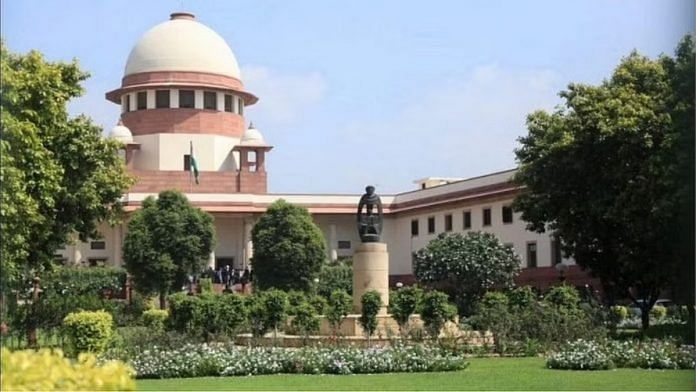New Delhi: The Supreme Court Wednesday modified its earlier direction that mandated a minimum 1 kilometre Eco Sensitive Zone (ESZ) around national parks and wildlife sanctuaries.
A 3 June, 2022, order had imposed a minimum 1 km ESZ around protected areas, stating “no new permanent structure shall be permitted to come up for whatsoever purpose within the ESZ”, sparking concerns about development and human habitation in these areas.
The Supreme Court said Wednesday that the previous order will not apply either to ESZs for which draft or final notifications have been issued by the Ministry of Environment, Forests and Climate Change (MoEFCC) or in case of proposals pending with the latter.
A bench led by Justice B.R. Gavai said the June 2022 direction would also not be applicable where the national parks and sanctuaries are located on inter-state borders and/or share common boundaries.
The bench said, “(Going by the 2022 order), if no permanent construction is to be permitted for any purpose, a villager who is desirous to reconstruct his house would not be permitted…Similarly, if the government decides to construct schools, dispensaries, anganwadis…and other basic structures for improvement of the life of the villagers, the same would also not be permitted.”
It added, “The effect of the order will be to prevent the state or the central government from constructing roads and provide other facilities to the villagers”.
The order was pronounced on the central government’s application to modify its earlier direction, after the June 2022 judgment sparked concerns related to development and existing land use.
Significantly, the judgment reserves the 2022 direction of prohibiting mining activities within one kilometer of protected areas.
Acknowledging that its June 2022 order would make it impossible for the forest departments to conduct eco-development activities around national parks and sanctuaries, the bench said such activities are required with the “dual objectives of protection of wildlife and provision of benefits for the local communities”.
Debadityo Sinha, lead, Climate & Ecosystems at the Vidhi Centre for Legal Policy, said while the judgment offers clarity in terms of how ESZs should be regulated, it could have gone a step further.
“The problem is that states are not declaring ESZs properly, because there is no incentive for them to do so. So many protected areas have commercial hotels and resorts mushrooming around them under the garb of homestays and ecotourism,” he said.
He added: “The purpose of ESZs is to limit activities in order to protect wildlife. The Supreme Court could have deliberated on how to regulate these activities a little more.”
Ministry guidelines on ESZs
Eco Sensitive Zones are buffer zones outside protected areas that can go up to 10 kilometres, and are meant to act as “shock absorbers” and a “transition zone” from protected to unprotected areas.
The MoEFCC laid down guidelines on the establishment of ESZs on 9 February 2011, saying that their width would have to be “kept flexible” and specific to the protected area in question.
This is because areas immediately outside protected areas have already undergone various stages of development, the ministry said, adding that as a “general principle”, ESZs can extend up to 10 kms.
The guideline also suggested activities that could be prohibited, permitted, and regulated within ESZs, creating a framework for regulation. Activities such as commercial mining, setting of saw mills, and polluting industries fell under the “prohibited” category, while establishment of hotels and resorts, commercial use of water, and changes in agricultural practices could be “regulated”.
Activities like ongoing agriculture and horticulture and water harvesting were listed as “permitted”.
June 2022 order
Though the June 2022 order said that keeping ESZ widths flexible was “reasonable”, it went on to impose a minimum 1 km ESZ width around all protected areas. The order relied on the 2012 suggestion of the SC’s Central Empowered Committee, which had recommended creating minimum ESZs for various types of protected areas.
The court admitted that this direction would permanently prohibit regulated and permissible activities as well as certain projects of national and strategic importance, such as construction of national highways, railways and defence-related infrastructure and also hamper day-to-day activities of the citizens residing in ESZs.
On perusing the existing guidelines issued by the MoEFCC for construction in ESZs, the court said that there are “inbuilt safeguards for preventing rampant construction and abuse of process, which may be detrimental to the development and maintenance of wildlife habitats”.
The June 2022 order also said that for development activities within ESZs to continue, permission from the principal chief conservator of forests (PCCF) of each state or Union Territory would be necessary.
While modifying this condition, the court observed Wednesday that if this were to happen, “the PCCF would be left with no other job except to consider such applications for permission to continue such activities,” given that millions of people live within the states and Union Territories.
“Even a farmer desirous to continue farming activities would be required to seek such permission. We find that such a direction is impossible to be implemented…If such a direction is continued, rather than avoiding man-animal conflict, it will intensify the same,” the order added.
(Edited by Smriti Sinha)



